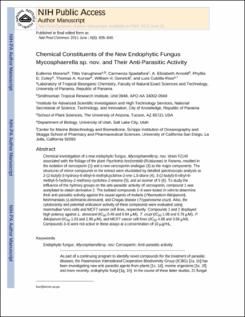| dc.contributor.author | Morenoa, Eufemio | |
| dc.contributor.author | Varughesea, Titto | |
| dc.contributor.author | Spadafora, Carmenza | |
| dc.contributor.author | Arnoldd, A. Elizabeth | |
| dc.contributor.author | Coley, Phyllis D. | |
| dc.contributor.author | Kursare, Thomas A. | |
| dc.contributor.author | Gerwickf, William H. | |
| dc.contributor.author | Cubilla-Riosa, Luis | |
| dc.date.accessioned | 2020-06-13T20:26:14Z | |
| dc.date.available | 2020-06-13T20:26:14Z | |
| dc.date.issued | 2011-06-15 | |
| dc.identifier.other | https://www.ncbi.nlm.nih.gov/pmc/articles/PMC3375898/ | |
| dc.identifier.uri | http://repositorio-indicasat.org.pa/handle/123456789/61 | |
| dc.description | Chemical investigation of a new endophytic fungus, Mycosphaerella sp. nov. strain F2140 associated with the foliage of the plant Psychotria horizontalis (Rubiaceae) in Panama, resulted in the isolation of cercosporin (1) and a new cercosporin analogue (3) as the major components. The structures of minor compounds in the extract were elucidated by detailed spectroscopic analysis as 2-(2-butyl)-3-hydroxy-6-ethyl-6-methylcyclohex-2-ene-1,5-dione (4), 3-(2-butyl)-6-ethyl-6methyl-5-hydroxy-2-methoxy-cyclohex-2-eneone (5), and an isomer of 5 (6). To study the influence of the hydroxy groups on the anti-parasitic activity of cercosporin, compound 1 was acetylated to obtain derivative 2. The isolated compounds 1–6 were tested in vitro to determine their anti-parasitic activity against the causal agents of malaria ( Plasmodium falciparum ), leishmaniasis ( Leishmania donovani ), and Chagas disease ( Trypanosoma cruzi ). Also, the cytotoxicity and potential anticancer activity of these compounds were evaluated using mammalian Vero cells and MCF7 cancer cell lines, respectively. Compounds 1 and 2 displayed high potency against L. donovani (IC50 0.46 and 0.64 μM), T. cruzi (IC50 1.08 and 0.78 μM), P. falciparum (IC50 1.03 and 2.99 μM), and MCF7 cancer cell lines (IC50 4.68 and 3.56 μM). Compounds 3–6 were not active in these assays at a concentration of 10 μg/mL. | en_US |
| dc.description.abstract | Chemical investigation of a new endophytic fungus, Mycosphaerella sp. nov. strain F2140 associated with the foliage of the plant Psychotria horizontalis (Rubiaceae) in Panama, resulted in the isolation of cercosporin (1) and a new cercosporin analogue (3) as the major components. The structures of minor compounds in the extract were elucidated by detailed spectroscopic analysis as 2-(2-butyl)-3-hydroxy-6-ethyl-6-methylcyclohex-2-ene-1,5-dione (4), 3-(2-butyl)-6-ethyl-6methyl-5-hydroxy-2-methoxy-cyclohex-2-eneone (5), and an isomer of 5 (6). To study the influence of the hydroxy groups on the anti-parasitic activity of cercosporin, compound 1 was acetylated to obtain derivative 2. The isolated compounds 1–6 were tested in vitro to determine their anti-parasitic activity against the causal agents of malaria ( Plasmodium falciparum ), leishmaniasis ( Leishmania donovani ), and Chagas disease ( Trypanosoma cruzi ). Also, the cytotoxicity and potential anticancer activity of these compounds were evaluated using mammalian Vero cells and MCF7 cancer cell lines, respectively. Compounds 1 and 2 displayed high potency against L. donovani (IC50 0.46 and 0.64 μM), T. cruzi (IC50 1.08 and 0.78 μM), P. falciparum (IC50 1.03 and 2.99 μM), and MCF7 cancer cell lines (IC50 4.68 and 3.56 μM). Compounds 3–6 were not active in these assays at a concentration of 10 μg/mL. | en_US |
| dc.language.iso | eng | en_US |
| dc.rights | https://creativecommons.org/licenses/by-nc-sa/4.0/ | |
| dc.rights | info:eu-repo/semantics/openAccess | |
| dc.subject | Endophytic fungus | en_US |
| dc.subject | Mycosphaerella sp. nov | en_US |
| dc.subject | Cercosporin | en_US |
| dc.subject | Anti-parasitic activity | en_US |
| dc.title | Chemical Constituents of the New Endophytic Fungus Mycosphaerella sp. nov. and Their Anti-Parasitic Activity | en_US |
| dc.type | info:eu-repo/semantics/article | en_US |
| dc.type | info:eu-repo/semantics/publishedVersion | |

